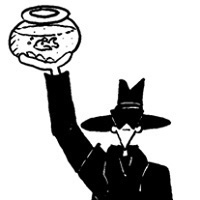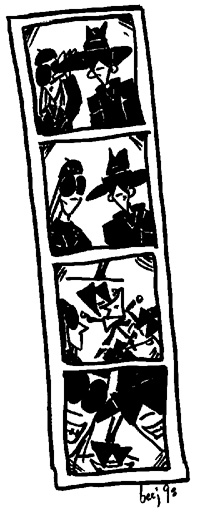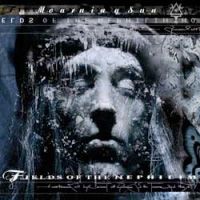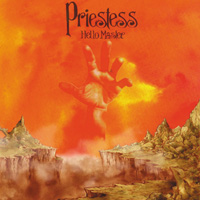 The Death Weasel
The Death Weasel
An interview with Ben Jones
by Chad Parenteau
In addition to gaining reknown for his ‘zine, The Violent Life of Death Weasel (three issues currently out), Ben Jones has also begun to acquire some legitimacy as a performance artist, a poet, and an actor, all while earning actual money as a video clerk. When Jones and I spoke back in August, he had just come back from being an extra in the upcoming Troma Productions film, Terror Firmer, a fictional documentary on the making of the never-actually-made fourth Toxic Avenger movie. Although he couldn’t reveal much about the movie, he was able to clue us in on how to spot him: “For several scenes, I’m wearing a fish.”
Jones, at that time, was in the beginning stages of his art, and was enjoying drawing sketches for people and describing his evolving stories and characters. Some of the characters he plans to reveal in future issues include “a giant pigeon wearing a pink angora sweater… a chain-smoking clam…” I inquired about one upcoming villain who’s supposed to have the head of a toaster.
“Whip out the pen,” he declared. I watched him as he crafted a visual aid for me. He fooled around with the toaster’s bread-slits. “Gotta have the gums in there. Makes him more evil.”
I inquired about the character’s lack of eyes. “Who needs eyes?” Jones cried out in mock-hysteria. “He’s a toaster. Where’s your suspension of disbelief?”
Equally amusing is the story of the real-life “origin” of the Death Weasel, whose trademark appearance is modeled after Jones himself.
 “It all started with the clothes,” admitted Jones, who said he’s been sporting the trenchcoat, fedora, and Ray-Bans since 1991. But the character’s name didn’t arise until Jones moved from Virginia to Boston in 1992 to study at Emerson College. There he became friends with fellow student and future sidekick Tim Coughlan, who shared this moment of inspiration with Jones during the winter of their freshman year, thus securing a role as a comic book sidekick.
“It all started with the clothes,” admitted Jones, who said he’s been sporting the trenchcoat, fedora, and Ray-Bans since 1991. But the character’s name didn’t arise until Jones moved from Virginia to Boston in 1992 to study at Emerson College. There he became friends with fellow student and future sidekick Tim Coughlan, who shared this moment of inspiration with Jones during the winter of their freshman year, thus securing a role as a comic book sidekick.
“I’m sitting on the shuttle bus, decked out in my fedora and my trenchcoat and my Ray-Bans, on my way back to the dorms. We make a stop at the library, and Tim jumps on, jumps into the seat next to me, points at me and says, ‘You are Death Weasel 2000!’ I look at him and say, ‘You are The Carnage Shrew!’ And for the rest of the way back to the dorms we’re like, ‘And we are the Raucous Rodents! We are rodents with rocks!’
“I dropped the 2000, ’cause it was kind of awkward,” he explained. Everything else was kept, even after Jones discovered that neither weasels nor shrews were rodents. Unfortunately, he didn’t find out until after posting his Deathweasel web page, “but the name [Raucous Rodents] was just too good to leave alone.”
Although his comics are primarily humorous, he cites more serious comics as influences, such as Neil Gaiman’s epic Sandman and Art Spiegelman’s holocaust story, Maus. “I was required to read Maus in a course…. Emerson actually makes you buy Maus, which I think is pretty cool.”
Still, it was Hyena, Emerson’s undergraduate humor magazine, in which his first Death Weasel strips appeared. These strips were later redone (some were discarded) for the mini-comic, as Jones felt they were not serious enough.
“I was going through the super-realistic thing… it’s what I was into.” His intention was to do a sort of pseudo-diary, mixing enough fact and fiction together to avoid self-interested narcissism. He wanted to portray “fictitious tales which took place where I walked…. So that way I would do this super-realistic drawing of the city so I could remember it for always.”
Jones said he burned out within a week after producing only three pages of the planned comic. “Suddenly Boston wasn’t that important,” he explained. “I had the character, and I was pretty happy where the character was, but I had no idea what to do with him.” In other words, the Death Weasel had the same problems as any other young person trying to find things to do at night.
 Other than the strips, the failed comic, and various sketches, Jones’ only other outlet was his website (www.deathweasel.com, where his earlier pre-comic book strips can still be seen). That is, until he met Richard Mackin, famed Allston-based writer, artist, and EAT Publications’ mastermind. “A local celebrity, in my mind,” said Jones.
Other than the strips, the failed comic, and various sketches, Jones’ only other outlet was his website (www.deathweasel.com, where his earlier pre-comic book strips can still be seen). That is, until he met Richard Mackin, famed Allston-based writer, artist, and EAT Publications’ mastermind. “A local celebrity, in my mind,” said Jones.
They started out as casual friends until Mackin began inviting Jones over on Sundays to watch The Simpsons and X Files. “After a year and a half or so of meeting there every week… he turned to me and said, ‘You need a ‘zine. I’m bored at work, and I’ve made so many copies of my own stuff that I don’t have any place to put them. You need a ‘zine. Make a ‘zine.'”
Not only did this get the Death Weasel project going, it also brought the two into collaboration on an upcoming comic called Wings of Indifference, a story about a “mid-life crisis” guardian angel who has recurring memories of his past life as a mortal.Jones got closer to his original goal of telling semi-biographical stories with issue three, which contains the story “Very Bad Weeks,” based on when he started taking Prozac in November of ’97. The two main characters were Death Weasel and the Weasel of Self-Abuse, who is the impish embodiment of Death Weasel’s self-loathing. What started out, said Jones, as the insulting punchline of a short strip he drew about forgetting to bring his sunglasses on a trip to Virginia, became “this great comic foil” that “allowed the Death Weasel to be pure.”
“I’m always conflicted about what’s right and what’s wrong… By separating the Death Weasel’s self-loathing into its own entity, he can be free to be sure of his convictions.”
By the end of “Very Bad Weeks,” Self-Abuse agrees to leave so Death Weasel can get back on his feet, but not before Self-Abuse gets his say: “Your depression is my identity. You’re killing me 20 mg. at a time!”
Jokes aside, Jones’ rendering of Death Weasel’s depression felt real. “Here’s my whiny, self-analytical piece,” thought Jones at the time; but he said friends have told him it was this story in which Jones found his voice. “It’s their favorite issue.”
Currently, he’s not sure whether this will be the new direction of the book. “Self-indulgence isn’t necessarily bad,” he admitted, adding that he has “always been torn about art” and how autobiographical or fictional it should be.
But for now, Jones will be going back to some serious truth-twisting for at least another issue. It will begin with the return of Self-Abuse, who resurfaces on the condition that he “not berate unless it has some sort of comic-relief aspect.” There will be more fictionalizing of people in Jones’ life and the world around him. The most notable is the addition of Gil Hova, who Jones also met at Emerson. They are currently working on a parody of The Crow called The Last Drop Always Ends Up In Your Pants. Hova will be appearing in issue four as a character called the Dream Muffin, who inhabits a Wacky Land type of mystical realm.
“He figures quite prominently,” said Jones, who revealed that Dream Muffin will also alter the Death Weasel’s world to reflect Boston less and to include more action and more interesting things for the Death Weasel to fight besides generic characters wearing “Faceless Thug” T-shirts. “I’m really not all that into humans,” admitted Jones.
Jones admits that Dream Muffin (named after the brand name of muffin Hova always ate in Emerson’s cafeteria), is a “dead rip off” of the character, Dream, in Sandman. Does he fear any legal opposition from the DC Comics/ Warner Brothers juggernaut? If I have to go to court, it’ll be good advertising,” he said. “It’s all in good fun.”
Ben Jones’ comics can be found at Million Year Picnic in Cambridge and Flyrabbit in Allston. His abandoned ‘zine, After The Beep, is a collection of answering machine poems recorded from Jones’ various callers. Inquiries can be made to Ben Jones at 263 Elm Street, #1, Cambridge, MA 02139



